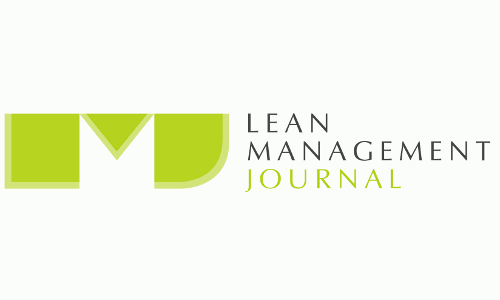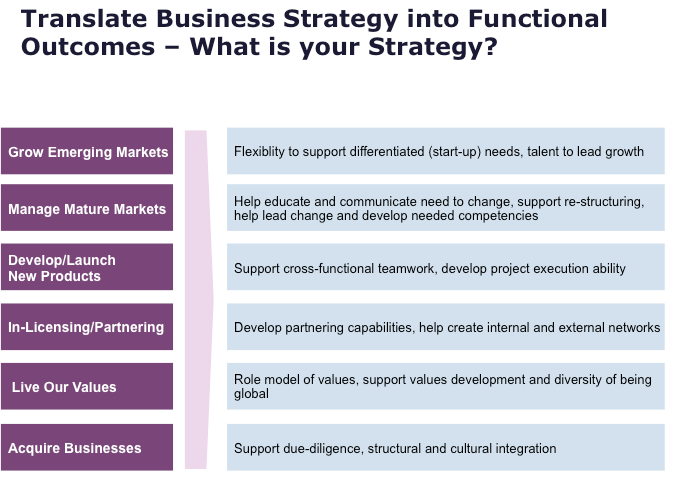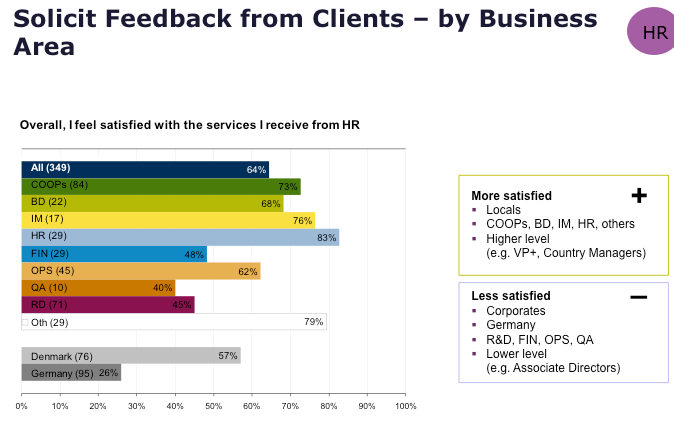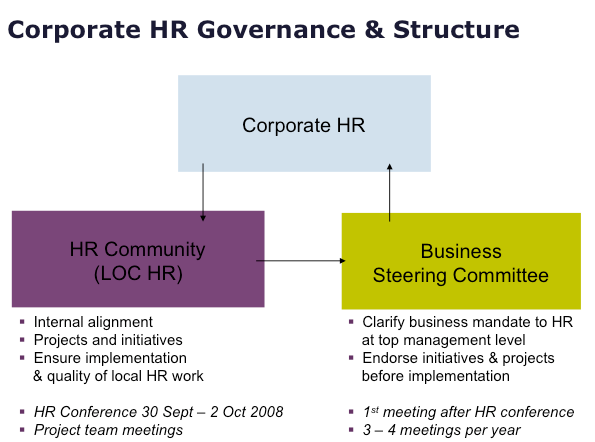A Roadmap for Developing Functional strategies
 CONTENT PARTNER CONTRIBUTION
CONTENT PARTNER CONTRIBUTION
As seen in the Jul-2015 edition of the
Lean Management Journal
Corporate strategies are important to define the overall direction for an organisation. But how do we make sure that the strategies for the various functional areas (manufacturing, human resources) are aligned with the overall direction of the firm as usually defined by its corporate strategy? This article describes an approach for formulating a strategy for a functional area that is developed and owned by the functional leadership team and helps address the key question: How do you create a functional strategy that effectively supports the corporate strategy while also achieving the specific operational objectives the function is expected to meet?
Alignment and ownership
The reality in most large organisations is that the strategies for the various functional areas are rarely well aligned with the overall corporate strategy and other functions. Not only does a lack of alignment result in wasting resources on activities and projects that do not support the overall strategy, but in many instances the lack of alignment can hinder the execution of the overall corporate strategy.
The process presented here includes both developing the functional strategy, and ensuring its execution.
By actively involving the functional management in the development of the functional strategy, key managers of that function take ownership of specific work streams and initiatives, ensuring full commitment during execution.
The main stakeholders, e.g. the CEO, peers and other internal customers give their input as to ensure the function is fully geared to meeting their key expectations.
From corporate strategy to functional outcomes
When developing a functional strategy, different sources of information can be used. In most cases, the corporate strategy is the first input. In addition, stakeholder surveys, as well as benchmarks or SWOT analysis can be used.
The key is to ensure that the expectation for the function is clearly defined as to meet the expectations of its main customers.
Take the example of a corporate HR function in a mid-size pharmaceutical company: The corporate strategy outlines six strategic objectives. What is the contribution HR needs to make to support the overall strategy?
On the left the corporate strategy, on the right in the corresponding human resources strategy that was developed
In the above example, through the HR strategy development, the apparent contradictory role for HR to support both emerging markets expansion and mature markets consolidation was clarified. Training in project management and building partnering skills to support was prioritised to support the corporate strategy.
Getting input from the CEO and peers on the leadership team is crucial not only to define the expectations, but also to ensure stakeholder buy-in and support. Asking what works and should be further pursued, what new activities should be pursued can yield crucial insights on where to focus.
In the example of the HR department, the vice president responsible for HR launched a general employee survey to assess to what extent the function was currently meeting employee expectations as well as identify specific gaps that needed to be addressed. The general survey helped to identify specific areas that needed to be addressed.
Gathering these inputs helps to ensure the functional strategy is grounded in the current reality.
Define strategic initiatives – must achieves
When it comes to functional strategies, there is typically no shortage of ideas for what could be done. But oftentimes there is only limited capacity to execute on all the ideas.
Focusing on the must-achieves based on stakeholder input was found crucial to focus on the right things and avoid resource drain.
A strategy development process also provides an opportunity to challenge the work currently being done by the function, prioritise the options and ensure buy-in for the chosen initiatives.
Figure three outlines the framework used to evaluate the relative importance and customer satisfaction impact and identify the vital few initiatives that the HR function should undertake.

Note in the above how employee branding is positioned low on the chart. Before this functional strategy exercise was done, it was one of the main activities that the HR function wanted to engage in. With the insight of this analysis the HR function could refocus on items of higher importance to employees.
Charter implementation projects and actions
When it comes to defining the actions, the ‘who’ is as important as the ‘what’. At its best, strategy development is an invitation to lead – by asking: “Where can you contribute both in your current role and through project work?”
The preferred way to achieve this is to make the strategy development a team effort by involving the management team of the function and to have each member take personal responsibility for an initiative and to seeing it implemented.
These initiatives should come in parallel to the normal delivery activities of the function, and should require no or very little additional resources, thus fitting within the existing budget, manning.
Some of these initiatives might be of a limited time to a few months while others could become part of a continuing improvement program.
Agree on performance KPIs
KPIs are critical to track progress against the overall strategy and to help those leading specific initiatives keep score on how they are doing. Figure four shows the framework used for assessing the progress made in improving how HR is being perceived by the business.
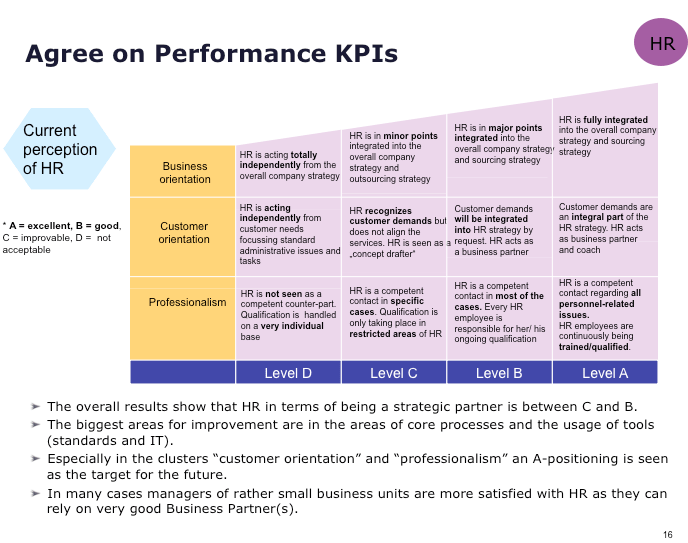
Developing a functional strategy aligned with the overall needs of the business is one thing. As the business develops and circumstances can change over time, maintaining that alignment is important. In addition to a robust set of KPIs, a business steering committee can be a very effective mechanism to maintain alignment and gather feedback. If the functional area has multiple layers (for example global, regional, local), creating a forum for the entire functional community is also a good option. Figure five outlines the structure used to provide periodic feedback.
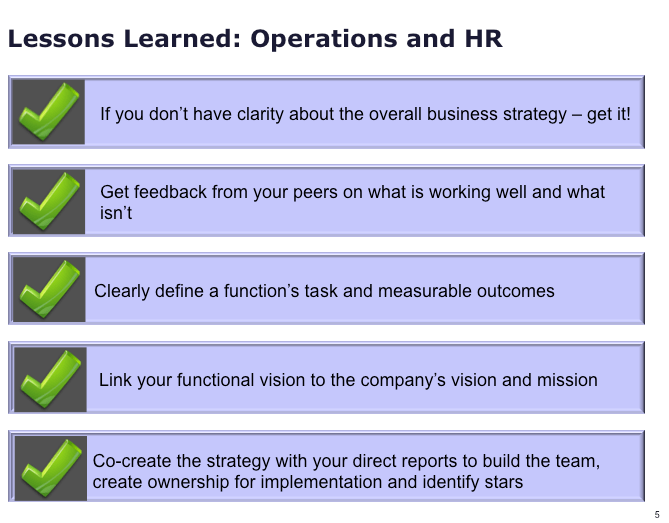
Conclusions
A good process for creating a functional strategy delivers both alignment and ownership. Figure six summarises the key lessons learned in the process of developing functional strategies.
Starting with the corporate strategy and gathering input from other functional areas defines the outcomes the strategy must help accomplish and helps to focus on the needs of the internal customers. Inviting the staff to lead and take ownership for specific projects and initiatives is critical. Creating KPIs and setting up feedback mechanisms helps to maintain alignment and track progress.
By Thomas Bertels and Charles Depasse
Thomas Bertels is the managing partner of Valeocon Management Consulting. Experienced management consultant with fifteen years experience helping global clients achieve sustainable business results. A recognized expert on operational excellence, metrics, and innovation, I help executives and teams at all levels define problems, develop strategies, as well as design and implement practical solutions. Connect with him on LinkedIn.
Charles Depasse is the former head of HR and operations for Nycomed. Connect with him on LinkedIn.
 CONTENT PARTNER CONTRIBUTION
CONTENT PARTNER CONTRIBUTION
As seen in the Jul-2015 edition of the
Lean Management Journal

